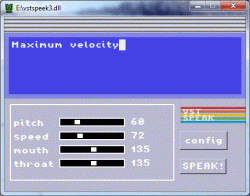
Blogosaur has released VST Speek for Windows – a free vocal synthesis VST plugin for recreating the ‘old skool robotic text to speech we all love’.
To use it, you just choose a preset, type some text and let it ‘speak’.
VST Speek is is based on the Software Automatic Mouth (SAM) vocal synthesis software created by Softvoice Inc for the Commodore 64. The original C64 software has been reverse engineered and ported to C by Sebastian Macke, and then adapted for this VST plugin.
Here’s an example of VST Speek in action:
Audio PlayerFeatures:
- trigger the speech with MIDI keyboard (velocity sensitive)
- use MIDI pitchbend
- change original pitch or mouth/throat parameters while it’s speaking
- This is not a vocal synth like Vocaloïd], it’s designed for ‘crunchy robotic lofi techno voices’.
Download at the Blogosaur site.

Whow!
I used an Atari emulator, to make this sound! :))
OMG YES!
Mac version, please!
I cant get it to work..
me neither. is it because i have windows 8?
This is so sweet… I’m TOTALLY making a voicemail greeting with this.
Just like Atari ST Captain Blood videogame. Never really understood what to do, but those “conversations” sounded great.
To get this same (authentic) effect on a Mac, I downloaded VICE, a free Commodore 64 emulator, found the disk image for S.A.M (Software Automated Mouth) then recorded its output using the simple and free WavTap. Not as difficult as it sounds and well worth it.
Nice one! Thanks!
The C-program which this VST is based on can easily be compiled on a Mac, if you are a little comfortable in the Terminal.
First, install Homebrew, a package-manager which gives access to lots of typical unix command line tools:
http://brew.sh
There are installation instructions on the page, basically a one-liner to run in the Terminal. Make sure you follow the instructions to correctly install Homebrew. It is quite a while since I did it myself, but it should be relatively straight forward.
After Homebrew is correctly installed, run the following commands in the Terminal
brew install sdl
cd ~/Downloads
git clone https://github.com/s-macke/SAM.git
cd SAM
make
You should now have an executable sam-file in the directory you are currently inside. Test it by running for instance:
./sam maximum velocity
To make a wav instead of output to your speakers, use
./sam -wav maxvelo.wav maximum velocity
Frooty loops had this same voice 10 years ago at least.. its stiil there.. and its free
I love you <3
Thank you so much this is the best!